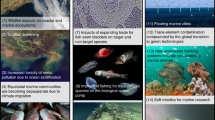Abstract
Marine biological invasions are increasingly recognised as a threat to biodiversity and coastal industry, including fisheries. Globally, efforts are underway to contain, if not eradicate, several high-impact marine invasive species. However, working in a marine environment places unique social, political and technical constraints on options for pest control, which we explored in a series of stakeholder workshops. Results suggest that current efforts are low risk and publicly acceptable, but have a low probability of success against established invaders. However, techniques deemed likely to be successful and ultimately needed in a marine context are currently more contentious for social and political reasons. To control introduced marine pests, scientists and managers will need to overcome perceptual biases among marine stakeholders, develop a decision-making framework for what is perceived to be an open system, and focus on technologies likely to be both effective and publicly and politically acceptable.
Similar content being viewed by others
References
Bax N, Carlton JT, Mathews-Amos A, Haedricj RL, Howarth FG, Purcell JE, Rieser A and Gray A (2001) The control of biological invasions in the world's oceans. Conservation Biology 15: 1234–1246
Bax N, Hayes K, Marshall A, Parry D and Thresher R (2002) Man-made marinas as sheltered islands for alien marine organisms: establishment and eradication of an alien invasive marine species. In: Veitch CR and Clout MN (eds) Turning the Tide: the Eradication of Invasive Species, 26–39. Occ. Pap. IUCN Species Survival Commission 27
Cheshire A, Westphalen G, Boxall V, Marsh R, Gilliland J, Collings G, Seddon S and Loo M (2002) Caulerpa taxifolia in West Lakes and the Port River: distribution and eradication options. South Australian Research and Development Institute Final Report
Cohen AN and Carlton JT (1998) Accelerating invasion rate in a highly invaded estuary. Science 279: 555–558
Cowen RK, Lwiza KMM, Sponaugle S, Paris CB and Olson DB (2000) Connectivity of marine populations: open or closed? Science 287: 857–859
Culver CS and Kuris AM (1999) The apparent eradication of a locally established introduced marine pest. Biological Invasions 2: 245–253
Jackson JBC, Kirby MX, Berger WH, Bjorndal KA, Botsford LW, Bourque BJ, Bradbury RH, Cooke R, Erlandson J, Estes JA, Hughes TP, Kidwell S, Lange CA, Lenihan HS, Pandolfi JM, Peterson CH, Steneck RS, Tegner MJ and Warner RR (2002) Historical overfishing and the recent collapse of coastal ecosystems. Science 293: 629–638.
Janzen D (1988) Gardenification of wildland nature and the human footprint. Science 279: 1312–1313
Kuris AM (2003) Eradication of introduced marine pests. In: Rapport DJ et al. (eds) Managing for Healthy Ecosystems, 549–556. Lewis Publishers, New York
Kuris AM and Lafferty KD (2000) Can biological control be developed as a safe and effective mitigation against established introduced marine pests? In: Pederson J (ed) Marine Bioinvasions, Proceedings of the First National Conference, pp 102–106. MIT Press, Boston
Lafferty KD and Kuris AM(1996) Biological control of marine pests. Ecology 77: 1989–2000
Mann R and Harding JM (2000) Invasion of the North American Atlantic coast by a large predatory Asian whelk. Biological Invasions 2: 7–22
Meinesz A and Thibault T (1998) The biological control of an invasive species in the open sea: need of an international decision. In: Boudouresque CF, Meinesz A and Gravez V (eds) Third International Workshop on Caulerpa taxifolia, 113–116. GIS Posidonie, Marseille, France
Meinesz A, Belsher T, Thibaut T, Antolic B, Ben Mustaha K, Bourdouresque C-F, Chiaverini D, Cinelli F, Cotalorda J-M, Dlellouli A, El Abed A, Orestano C, Grau AM, Ivesa L, Jaklin A, Langar H, Massuti-Pascual E, Peirano A, Tunesi L, de Vaugelas J, Zavodnik N and Zuljevic A (2001) The introduced green alga Caulerpa taxifolia continues to spread in the Mediterranean. Biological Invasions 3: 201–210
Mitchell CE and Power AG (2003) Release of invasive plants from fungal and viral pathogens. Nature 421: 625–627
Norton GA (1983) Decision making in pest control. Advances in Applied Biology 8: 87–119
Norton GA (1988) Philosophy, concepts and techniques In: Norton GA and Pech RP (eds) Vertebrate Pest Management in Australia, 1–17. CSIRO Publications, Canberra, Australia
Sponaugle S, Cowen RK, Shanks A, Morgan SG, Leis JM, Pineda J, Boehlert GW, Kingsford MJ, Lindeman KC, Grimes C and Munro JL (2002) Predicting self-recruitment in marine populations: biophysical correlates and mechanisms. Bulletin of Marine Science 70(Supplement): 341–375
Thresher RE (2000) Key threats from marine bio invasions: a review of current and future issues. In: Pederson J (ed) Marine Bioinvasions, Proceedings of the First National Conference, 24–34. MIT Press, Boston
Thresher RE, Proctor C, Ruiz G, Gurney R, MacKinnon C, Walton W, Rodruiguez L and Bax N (2003) Invasion dynamics of the European shore crab, Carcinus maenas, in Australia. Marine Biology 142: 867–876
Torchin ME, Lafferty KD and Kuris AM (2001) Release from parasites as natural enemies: increased performance of a globally introduced marine crab. Biological Invasions 3: 333–345
Torchin ME, Lafferty KD, Dobson AP, McKenzie VJ and Kuris AM (2003) Introduced species and their missing parasites. Nature 421: 628–630
Williams SL and Grosholz ED (2002) Preliminary reports from the Caulerpa taxifolia invasion in southern California. Marine Ecology Progress Series 233: 307–310
Woodfield R (2002) Noxious seaweed found in southern California coastal waters. Ballast Exchange 4: 8–9
Author information
Authors and Affiliations
Corresponding author
Rights and permissions
About this article
Cite this article
Thresher, R.E., Kuris, A.M. Options for Managing Invasive Marine Species. Biological Invasions 6, 295–300 (2004). https://doi.org/10.1023/B:BINV.0000034598.28718.2e
Issue Date:
DOI: https://doi.org/10.1023/B:BINV.0000034598.28718.2e




